Snorkel X26 User Manual [en, de, es, fr, it]
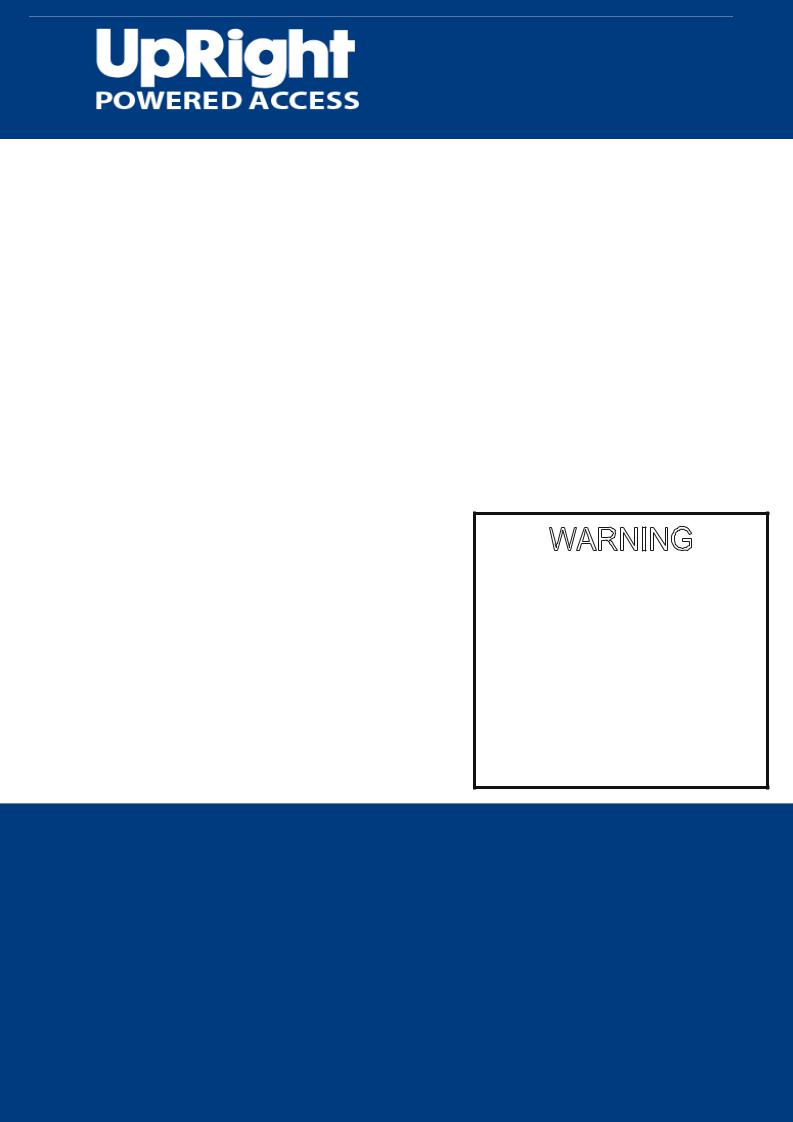
X26-32
Operator Manual
This first section of the Operator manual is the English language version.
Betriebsanleitung
Im zweiten Abschnitt dieser Betriebsanleitung finden Sie die Deutsche Version.
Manuel Utilisateur
èLa troisième section de ce manuel est la version en langue Française.
Manual del Usuario
El apartado cuarto de este manual del usuario corresponde a la versión en Español.
Manuale d’Uso
La quinta sezione di questo manuale d'uso è la versione in lingua Italiana.
 WARNING
WARNING 
The X32 Machine has been re-assessed to ensure compliance to the Machinery Directive (2006/42/EC).
The Machine rating has been changed from:
Windspeed rating of 12.5 m/s (Beaufort 6)
To
Windspeed rating of 7 m/s (Beaufort 4)
Please attach to the front cover of |
|
your X32 manual |
510329-000 |
(EN) Manual part number 504165-002. (DE) Bestellnummer 504165-002.
(FR) Manuel Pièce numéro 504165-002.
(ES) El número de referencia para el manual es el 504165-002. (IT) Manuale Ricambi Numero 504165-002.

X 26-32
X26 Serial Numbers 50906 – 53099
X32 Serial Numbers 50322 – 53099
ENGLISH
When contacting Upright for service or parts information, be sure to include the MODEL and SERIAL NUMBERS from the equipment nameplate. Should the nameplate be missing, the SERIAL NUMBER is also stamped on top of the chassis above the front axle pivot.
Stamped Serial Number
Estampille de numéro de série
Eingestanzte Seriennummer

OPERATION MANUAL
WARNING
All personnel shall carefully read, understand and follow all safety rules and operating instructions before operating or performing maintenance on any UpRight aerial work platform.
Safety Rules
Electrocution Hazard |
Tip Over Hazard |
Collision Hazard |
Fall Hazard |
|
NEVER elevate the platform or drive |
|
|
|
NEVER climb, stand, or sit on |
|
THIS MACHINE IS NOT |
|
NEVER position the platform |
|
|||
the machine while elevated unless the |
without first checking for overhead |
platform guardrails or midrail. |
||||
INSULATED! |
||||||
machine is on a firm, level surface. |
obstructions or other hazards. |
|
||||
|
|
|||||
|
|
|
|
|
|
|
USE OF THE AERIAL WORK PLATFORM: This aerial work platform is intended to lift persons and his tools as well as the material used for the job. It is designed for repair and assembly jobs and assignments at overhead workplaces (ceilings, cranes, roof structures, buildings etc.). All other uses of the aerial work platform are prohibited!
THIS AERIAL WORK PLATFORM IS NOT INSULATED! For this reason it is imperative to keep a safe distance from live parts of electrical equipment!
Exceeding the specified permissible maximum load is prohibited! See “Special Limitations” on page 4 for details.
The use and operation of the aerial work platform as a lifting tool or a crane (lifting of loads from below upwards or from up high on down) is prohibited!
NEVER exceed the manual force allowed for this machine. See “Special Limitations” on page 4 for details.
DISTRIBUTE all platform loads evenly on the platform.
NEVER operate the machine without first surveying the work area for surface hazards such as holes, drop-offs, bumps, curbs, or debris; and avoiding them.
OPERATE machine only on surfaces capable of supporting wheel loads.
NEVER operate the machine when wind speeds exceed this machine’s wind rating. See “Beaufort Scale” on page 4 for details.
IN CASE OF EMERGENCY push EMERGENCY STOP switch to deactivate all powered functions.
IF ALARM SOUNDS while platform is elevated, STOP, carefully lower platform. Move machine to a firm, level surface.
Climbing up the railing of the platform, standing on or stepping from the platform onto buildings, steel or prefab concrete structures, etc., is prohibited!
Dismantling the swing gate or other railing components is prohibited! Always make certain that the swing gate is closed and securely locked!
It is prohibited to keep the swing gate in an open position (held open with tie-straps) when the platform is raised! To extend the height or the range by placing of ladders, scaffolds or similar devices on the platform is prohibited! NEVER perform service on machine while platform is elevated without blocking elevating assembly.
INSPECT the machine thoroughly for cracked welds, loose or missing hardware, hydraulic leaks, loose wire connections, and damaged cables or hoses before using.
VERIFY that all labels are in place and legible before using.
NEVER use a machine that is damaged, not functioning properly, or has damaged or missing labels.
To bypass any safety equipment is prohibited and presents a danger for the persons on the aerial work platform and in its working range.
NEVER charge batteries near sparks or open flame. Charging batteries emit explosive hydrogen gas. Modifications to the aerial work platform are prohibited or permissible only at the approval by UpRight. AFTER USE, secure the work platform from unauthorized use by turning both keyswitches off and removing key. The driving of MEWPs on the public highways is subject to regulations made under the Road Traffic Acts.
Page 1

504165-002
CONTENTS
Introduction . . . . . . . . . . . . . . . . . . . . . . . . . . . . . . . . . . . . . . . . . . . . . . . . . . . . . . . . . . . . . . . . . . . . . . . . . .3
General Description . . . . . . . . . . . . . . . . . . . . . . . . . . . . . . . . . . . . . . . . . . . . . . . . . . . . . . . . . . . . . . . . . . .3
Special Limitations . . . . . . . . . . . . . . . . . . . . . . . . . . . . . . . . . . . . . . . . . . . . . . . . . . . . . . . . . . . . . . . . . . . .4
Platform Capacity . . . . . . . . . . . . . . . . . . . . . . . . . . . . . . . . . . . . . . . . . . . . . . . . . . . . . . . . . . . . . . . . . . . . . . . . . . . 4
Manual Force . . . . . . . . . . . . . . . . . . . . . . . . . . . . . . . . . . . . . . . . . . . . . . . . . . . . . . . . . . . . . . . . . . . . . . . . . . . . . . 4
Beaufort Scale. . . . . . . . . . . . . . . . . . . . . . . . . . . . . . . . . . . . . . . . . . . . . . . . . . . . . . . . . . . . . . . . . . . . . . . . . . . . . . 4
Lift Overload Alarm . . . . . . . . . . . . . . . . . . . . . . . . . . . . . . . . . . . . . . . . . . . . . . . . . . . . . . . . . . . . . . . . . . . . . . . . . . 4
Controls and Indicators . . . . . . . . . . . . . . . . . . . . . . . . . . . . . . . . . . . . . . . . . . . . . . . . . . . . . . . . . . . . . . . .5 Pre-Operation Safety Inspection . . . . . . . . . . . . . . . . . . . . . . . . . . . . . . . . . . . . . . . . . . . . . . . . . . . . . . . . .6 System Function Inspection . . . . . . . . . . . . . . . . . . . . . . . . . . . . . . . . . . . . . . . . . . . . . . . . . . . . . . . . . . . .7
Operation . . . . . . . . . . . . . . . . . . . . . . . . . . . . . . . . . . . . . . . . . . . . . . . . . . . . . . . . . . . . . . . . . . . . . . . . . . . .8
Platform Extension . . . . . . . . . . . . . . . . . . . . . . . . . . . . . . . . . . . . . . . . . . . . . . . . . . . . . . . . . . . . . . . . . . . . . . . . . . 8 Travel With the Platform Lowered . . . . . . . . . . . . . . . . . . . . . . . . . . . . . . . . . . . . . . . . . . . . . . . . . . . . . . . . . . . . . . . 8 Steering . . . . . . . . . . . . . . . . . . . . . . . . . . . . . . . . . . . . . . . . . . . . . . . . . . . . . . . . . . . . . . . . . . . . . . . . . . . . . . . . . . . 8 Elevating the Platform . . . . . . . . . . . . . . . . . . . . . . . . . . . . . . . . . . . . . . . . . . . . . . . . . . . . . . . . . . . . . . . . . . . . . . . . 8 Travel With the Platform Elevated. . . . . . . . . . . . . . . . . . . . . . . . . . . . . . . . . . . . . . . . . . . . . . . . . . . . . . . . . . . . . . . 9 Lowering the Platform . . . . . . . . . . . . . . . . . . . . . . . . . . . . . . . . . . . . . . . . . . . . . . . . . . . . . . . . . . . . . . . . . . . . . . . . 9 Emergency Lowering. . . . . . . . . . . . . . . . . . . . . . . . . . . . . . . . . . . . . . . . . . . . . . . . . . . . . . . . . . . . . . . . . . . . . . . . . 9
X26. . . . . . . . . . . . . . . . . . . . . . . . . . . . . . . . . . . . . . . . . . . . . . . . . . . . . . . . . . . . . . . . . . . . . . . . . . . . . . . . . . . 9 X32. . . . . . . . . . . . . . . . . . . . . . . . . . . . . . . . . . . . . . . . . . . . . . . . . . . . . . . . . . . . . . . . . . . . . . . . . . . . . . . . . . . 9 Lower the Guardrails, X26. . . . . . . . . . . . . . . . . . . . . . . . . . . . . . . . . . . . . . . . . . . . . . . . . . . . . . . . . . . . . . . . . . . . 10 Lowering Procedure . . . . . . . . . . . . . . . . . . . . . . . . . . . . . . . . . . . . . . . . . . . . . . . . . . . . . . . . . . . . . . . . . . . . . 10 Raising Procedure . . . . . . . . . . . . . . . . . . . . . . . . . . . . . . . . . . . . . . . . . . . . . . . . . . . . . . . . . . . . . . . . . . . . . . 10 Fold Down guardrails, X32 . . . . . . . . . . . . . . . . . . . . . . . . . . . . . . . . . . . . . . . . . . . . . . . . . . . . . . . . . . . . . . . . . . . 11 Fold Down Procedure . . . . . . . . . . . . . . . . . . . . . . . . . . . . . . . . . . . . . . . . . . . . . . . . . . . . . . . . . . . . . . . . . . . 11 Erection Procedure . . . . . . . . . . . . . . . . . . . . . . . . . . . . . . . . . . . . . . . . . . . . . . . . . . . . . . . . . . . . . . . . . . . . . 11
Towing or Winching . . . . . . . . . . . . . . . . . . . . . . . . . . . . . . . . . . . . . . . . . . . . . . . . . . . . . . . . . . . . . . . . . .12
Parking Brake Release . . . . . . . . . . . . . . . . . . . . . . . . . . . . . . . . . . . . . . . . . . . . . . . . . . . . . . . . . . . . . . . . . . . . . . 12 After Use Each Day. . . . . . . . . . . . . . . . . . . . . . . . . . . . . . . . . . . . . . . . . . . . . . . . . . . . . . . . . . . . . . . . . . . . . . . . . 12 Hour Meter . . . . . . . . . . . . . . . . . . . . . . . . . . . . . . . . . . . . . . . . . . . . . . . . . . . . . . . . . . . . . . . . . . . . . . . . . . . . . . . 12
Transporting the Work Platform . . . . . . . . . . . . . . . . . . . . . . . . . . . . . . . . . . . . . . . . . . . . . . . . . . . . . . . .13
Preparation for Shipment . . . . . . . . . . . . . . . . . . . . . . . . . . . . . . . . . . . . . . . . . . . . . . . . . . . . . . . . . . . . . . . . . . . . 13 Lifting By Crane. . . . . . . . . . . . . . . . . . . . . . . . . . . . . . . . . . . . . . . . . . . . . . . . . . . . . . . . . . . . . . . . . . . . . . . . . . . . 13 By Forklift . . . . . . . . . . . . . . . . . . . . . . . . . . . . . . . . . . . . . . . . . . . . . . . . . . . . . . . . . . . . . . . . . . . . . . . . . . . . . . . . 13 Driving or Winching onto a Truck or Trailer. . . . . . . . . . . . . . . . . . . . . . . . . . . . . . . . . . . . . . . . . . . . . . . . . . . . . . . 13
Maintenance . . . . . . . . . . . . . . . . . . . . . . . . . . . . . . . . . . . . . . . . . . . . . . . . . . . . . . . . . . . . . . . . . . . . . . . .14
Blocking The Elevating Assembly . . . . . . . . . . . . . . . . . . . . . . . . . . . . . . . . . . . . . . . . . . . . . . . . . . . . . . . . . . . . . . 14
Scissor Brace Installation. . . . . . . . . . . . . . . . . . . . . . . . . . . . . . . . . . . . . . . . . . . . . . . . . . . . . . . . . . . . . . . . . 14
Scissor Brace Stowage . . . . . . . . . . . . . . . . . . . . . . . . . . . . . . . . . . . . . . . . . . . . . . . . . . . . . . . . . . . . . . . . . . 14
Battery Maintenance . . . . . . . . . . . . . . . . . . . . . . . . . . . . . . . . . . . . . . . . . . . . . . . . . . . . . . . . . . . . . . . . . . . . . . . . 15
Battery Charging . . . . . . . . . . . . . . . . . . . . . . . . . . . . . . . . . . . . . . . . . . . . . . . . . . . . . . . . . . . . . . . . . . . . . . . 15
Inspection and Maintenance Schedule. . . . . . . . . . . . . . . . . . . . . . . . . . . . . . . . . . . . . . . . . . . . . . . . . . .16
Daily Preventative Maintenance Checklist . . . . . . . . . . . . . . . . . . . . . . . . . . . . . . . . . . . . . . . . . . . . . . . .16
Labels . . . . . . . . . . . . . . . . . . . . . . . . . . . . . . . . . . . . . . . . . . . . . . . . . . . . . . . . . . . . . . . . . . . . . . . . . . . . .17
Specifications . . . . . . . . . . . . . . . . . . . . . . . . . . . . . . . . . . . . . . . . . . . . . . . . . . . . . . . . . . . . . . . . . . . . . . .19
Page 2 |
Operation Manual |
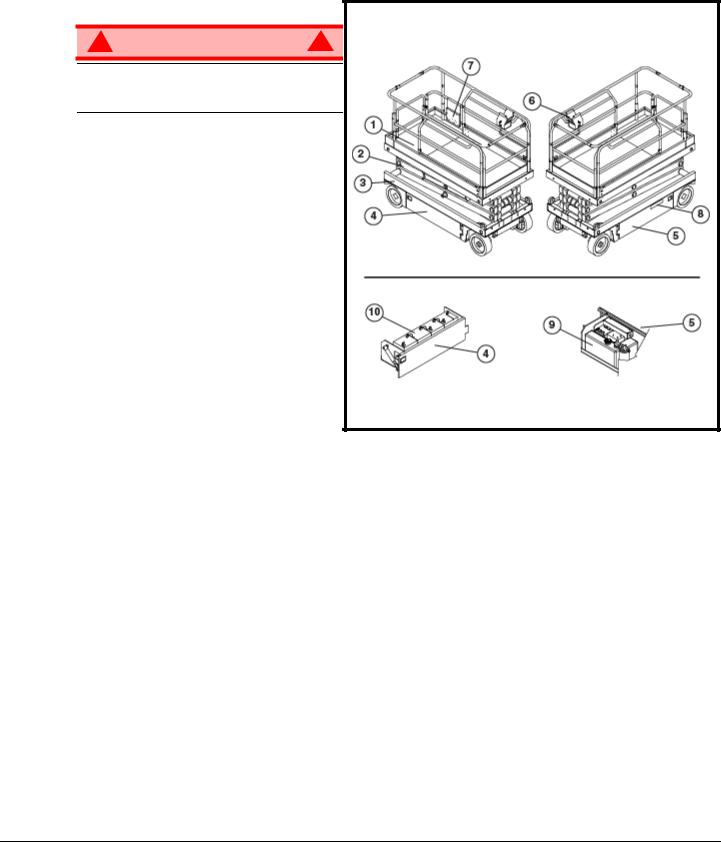
Introduction |
504165-002 |
INTRODUCTION
This manual covers operation of the X 26-32 Self-Propelled Work Platforms.
This manual must be stored on the machine at all times.
GENERAL DESCRIPTION
Figure 1: X 26-32
! W A R N I N G !
DO NOT use the maintenance platform without guardrails properly assembled and in place
1.Platform
2.Elevating Assembly
3.Chassis
4.Power Module
5.Control Module
6.Platform Controls
7.Manual Case
8.Chassis Controls
9.Hydraulic Fluid Reservoir
10.Batteries
Operation Manual |
Page 3 |
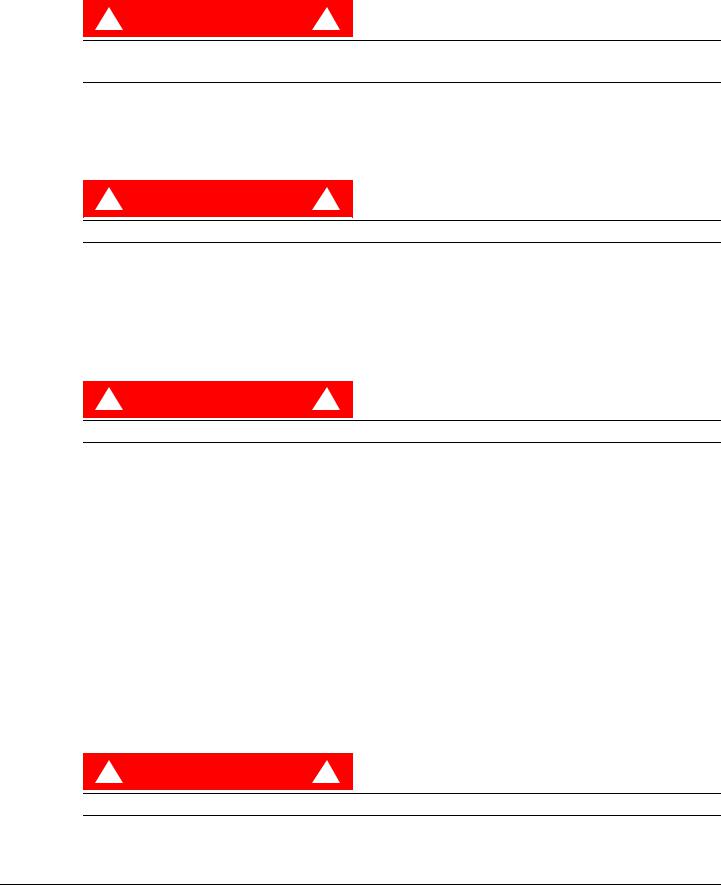
504165-002 |
Special Limitations |
SPECIAL LIMITATIONS
Travel with the platform raised is limited to creep speed range.
Elevating the Work Platform is limited to firm, level surfaces only.
!D A N G E R !
The elevating function shall ONLY be used when the work platform is level and on a firm surface.
The work platform is NOT intended to be driven over uneven, rough, or soft terrain.
PLATFORM CAPACITY
The maximum capacity for the MACHINE, including occupants is determined by model and options, and is listed in “Decals” on page 18.
!D A N G E R !
DO NOT exceed the maximum platform capacity or the platform occupancy limits for this machine.
MANUAL FORCE
Manual force is the force applied by the occupants to objects such as walls or other structures outside the work platform.
The maximum allowable manual force is limited to 200 N (45 lbs.) of force per occupant, with a maximum of 400 N (90 lbs.) for two or more occupants.
!D A N G E R !
DO NOT exceed the maximum amount of manual force for this machine.
BEAUFORT SCALE
Never operate the machine when wind speeds exceed 25 km/h (15 mph) [Beaufort scale 4].
BEAUFORT |
|
WIND SPEED |
|
GROUND CONDITIONS |
||
RATING |
m/s |
km/h |
ft/s |
mph |
||
|
||||||
3 |
3,4~5,4 |
12,25~19,4 |
11.5~17.75 |
7.5~12.0 |
Papers and thin branches move, flags wave. |
|
4 |
5,4~8,0 |
19,4~28,8 |
17.75~26.25 |
12.0~18 |
Dust is raised, paper whirls up, and small branches sway. |
|
5 |
8,0~10,8 |
28,8~38,9 |
26.25~35.5 |
18~24.25 |
Shrubs with leaves start swaying. Wave crests are apparent in ponds or swamps. |
|
6 |
10,8~13,9 |
38,9~50,0 |
35.5~45.5 |
24.5~31 |
Tree branches move. Power lines whistle. It is difficult to open an umbrella. |
|
7 |
13,9~17,2 |
50,0~61,9 |
45.5~56.5 |
31.~38.5 |
Whole trees sway. It is difficult to walk against the wind. |
|
LIFT OVERLOAD ALARM
If a load equivalent to 90% of safe working load is lifted a fault code “03” will be displayed on the digital display on the platform control box. If a load which is greater than the safe working load is present in the basket all machine functions will cease to operate and an acoustic warning will sound. In order to return to normal operation a load equal to or less than the safe working load must be present in the basket and the power must be re-cycled, power can be re-cycled by pushing the emergency stop button and releasing it again.
!D A N G E R !
Never operate the machine with a platform load greater than the rated capacity.
Page 4 |
Operation Manual |

Controls and Indicators |
504165-002 |
CONTROLS AND INDICATORS
Figure 2: Controls and Indicators
Platform Controls
4
6
3
1
1 |
Drive Selectors |
2 |
5 |
|
2. |
Horn Button |
|||
|
|
3.Lift/Lower Button
4.Emergency Stop Button
5.Display
6.Joystick
Chassis Controls
1 |
2 |
3 |
4 |
1.Keyswitch
2.Enable Button
3.Toggle Switch (Up & Down)
4.Emergency Stop Switch
Operation Manual |
Page 5 |

504165-002 |
Pre-Operation Safety Inspection |
PRE-OPERATION SAFETY INSPECTION |
|
NOTE: Carefully read, understand and follow all safety rules, operating instructions, labels and National Safety Instructions/Requirements. Perform the following steps each day before use.
1. Open modules and inspect for damage, fluid leaks or missing parts.
Figure 3: Hydraulic Tank
2.Check the level of the hydraulic fluid with the platform fully lowered. The hydraulic reservoir is located in the Control Module Door. The fluid level must be between the MIN and MAX lines. Add hydraulic fluid if necessary.
3.Check that fluid level in the batteries is correct.
4.Verify that batteries are charged.
5.Check that A.C. extension cord has been disconnected from the plug in the rear of the machine.
6.Check that all guardrails are in place and all fasteners are properly tightened.
7.Inspect the machine thoroughly for cracked welds and structural damage, loose or missing hardware, hydraulic
leaks, damaged control cable, loose wire connections and wheel bolts.
Page 6 |
Operation Manual |

System Function Inspection |
504165-002 |
SYSTEM FUNCTION INSPECTION
Refer to Figure 2 for the locations of various controls and indicators.
! W A R N I N G !
STAND CLEAR of the work platform while performing the following checks.
Before operating the work platform, survey the work area for surface hazards such as holes, drop-offs, bumps and debris.
Check in ALL directions, including above the work platform, for obstructions and electrical conductors. Protect the control console cable from possible damage while performing checks.
1.Move the machine, if necessary, to an unobstructed area to allow for full elevation.
2.Pull Chassis Emergency Stop Switch to the ON position.
3.Pull Platform Emergency Stop Switch to the ON position.
4.Turn and hold the Chassis Key Switch to the ON position. Push the Chassis Lift/Lower Switch to the UP position and raise the platform approximately 2,1 m (7 feet). BLOCK THE ELEVATING ASSEMBLY AS
DESCRIBED ON PAGE 9.
5.Visually inspect the elevating assembly, lift cylinder, cables, and hoses for cracked welds and structural damage, loose hardware, hydraulic leaks, loose wire connections, and erratic operation. Check for missing or loose parts.
6.Verify that the Depression Mechanism Supports have rotated into position under the machine. REMOVE
THE SCISSOR BRACE AS DESCRIBED ON page 13.
7.Push the Chassis Lift/Lower Switch to the UP position and fully elevate the platform.
8.Partially lower the platform by pushing Chassis Lift/Lower Switch to LOWER, and check for proper operation of the audible lowering alarm.
9.Open the Emergency Lowering Valve (see Figure 5) by pulling the knob out to check for proper operation. When the platform is lowered, release the knob.
10.Push the Chassis Emergency Stop Switch to check for proper operation. All machine functions should be disabled. Pull out the Chassis Emergency Stop Switch to resume.
11.Check that the route is clear of obstacles (persons, obstructions, holes, and drop-offs, bumps and debris), is level, and is capable of supporting the wheel loads.
12.Mount the platform and properly close the entrance.
13.Mount the platform and select DRIVE mode.
NOTE: Use both HI and LOW drive (if applicable) when performing the following step.
14.While engaging the Interlock Switch, move the Control Handle to FORWARD, then REVERSE, to check for speed control.
15.Push the Steering Switch RIGHT, then LEFT, to check for steering control.
16.Select LIFT mode. Grasp the Control Handle, engaging the Interlock Switch, and push it forward to check platform lift controls. Raise the platform to full elevation.
17.Pull back on the Control Handle. The platform should descend and the audible lowering alarm should sound.
18.Push the Platform Emergency Stop Switch to check for proper operation. All machine functions should be disabled. Pull out the Platform Emergency Stop Switch to resume.
Operation Manual |
Page 7 |
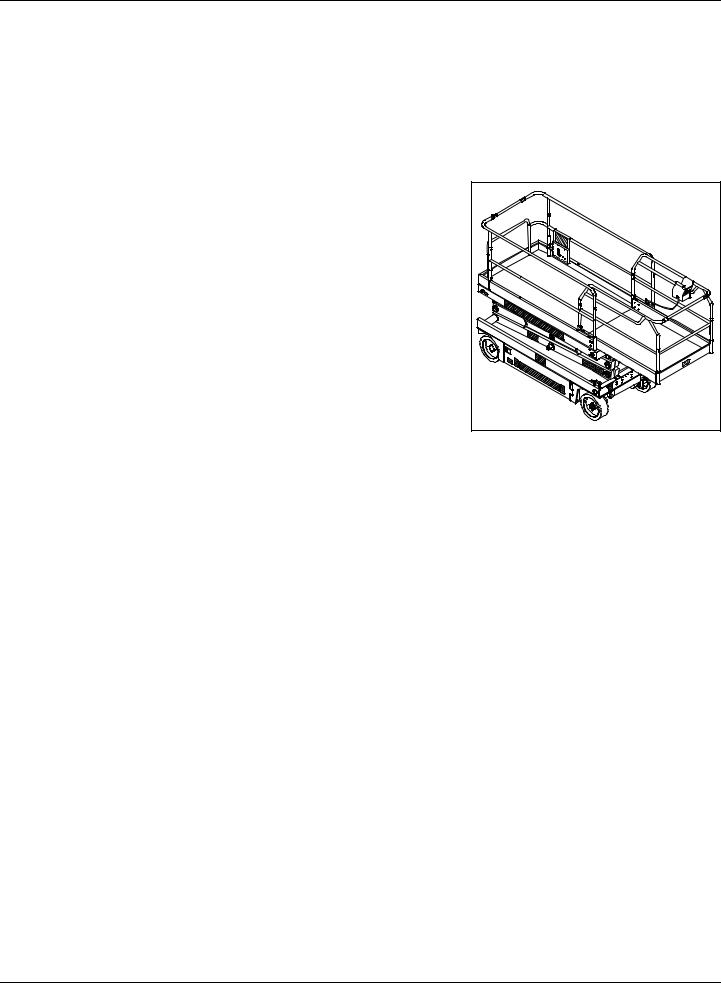
504165-002
OPERATION
Before operating the work platform, ensure that the Pre-Operation Safety Inspection has been completed and that any deficiencies have been corrected. Never operate a damaged or malfunctioning machine.
The operator must be thoroughly trained on this machine.
PLATFORM EXTENSION
Figure 4: Platform Extension
1.Mount the platform and properly close the entrance.
2.Depress the foot lever located at the rear of the platform extension. Push the platform extension forward until the pin engages the front stop.
3.To retract the platform extension, depress the foot lever and pull the platform extension toward the rear of the
machine until the pin engages the rear stop.
TRAVEL WITH THE PLATFORM
LO W E RE D
1.Check that the route is clear of obstacles (persons, obstructions, holes, drop-offs, bumps, and debris), is level, and is capable of supporting the wheel loads.
2.Verify that the Chassis Key Switch is turned to ON and the Chassis Emergency Stop Switch is ON (pulled out).
3.Mount the platform and properly close the entrance.
4.Check clearances above, below, and to the sides of platform.
5.Pull the Platform Emergency Stop Switch out to the ON position.
6.Select DRIVE mode.
NOTE: Choose between standard drive and extra torque depending on the gradient.
7.Engage the Interlock Switch and move the Control Handle to FORWARD or REVERSE to travel in the desired direction. The speed of the machine will vary depending on how far from centre the Control Handle is moved.
STEERING
1.Turn the Drive/Lift Switch to DRIVE.
2.While engaging the Interlock Switch, push the Steering Switch to RIGHT or LEFT to turn the wheels in the desired direction. Observe the tires while manoeuvring the work platform to ensure proper direction.
NOTE: Steering is not self-centring. Wheels must be returned to the straight ahead position by operating the Steering Switch.
ELEVATING T HE PLATFORM
1.Select a firm, level surface.
2.Select LIFT mode.
3.While engaging the Interlock Switch, push the Control Handle forward.
4.If the machine is not level the tilt alarm will sound and the machine will not lift or drive. If the tilt alarm sounds the platform must be lowered and the machine moved to a firm level surface before attempting to re-elevate the platform.
NOTE: Depression Mechanism supports will deploy automatically as the platform elevates and will retract after the platform has been lowered completely and has been driven.
Page 8 |
Operation Manual |
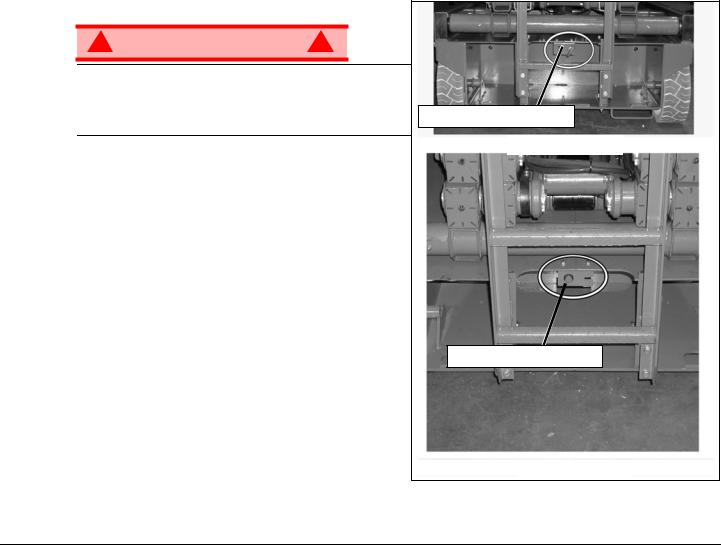
Operation |
504165-002 |
TRAVEL WITH THE PLATFORM ELEVATED
NOTE: The machine will travel at reduced speed when the platform is elevated.
1.Check that the route is clear of obstacles (persons, obstructions, holes, drop-offs, bumps, and debris), is level, and is capable of supporting the wheel loads.
2.Check clearances above, below, and to the sides of platform.
3.Select DRIVe mode.
4.Engage the Interlock Switch and move the Control Handle to FORWARD or REVERSE to travel in the desired direction. The speed of the machine will vary depending on how far from centre the Control Handle is moved.
5.If the machine is not level the tilt alarm will sound and the machine will not lift or drive. If the tilt alarm sounds the platform must be lowered and the machine moved to a firm, level surface before attempting to re-elevate the platform.
LOWERING THE PLATFORM
1.Select LIFT mode.
2.Check around the base of the platform to ensure that no one is in contact with the machine. Engage the Interlock Switch and pull back on the Control Handle to lower the platform.
3.The platform will stop when it reaches the PPE cutout height. Inspect around the machine to ensure no one is in contact with the machine. After a four-second time delay, lower the platform as in step 2.
EMERGENCY LOWERING
Figure 5: Emergency Lowering Valve
! W A R N I N G !
If the platform should fail to lower, NEVER climb down the elevating assembly.
Stand clear of the elevating assembly while operating the Emergency Lowering Valve Knob.
X26
The Emergency Lowering Valve for the X26 is located at the rear of the machine, above the charger.
1.Open the Emergency Lowering Valve by pulling and holding the knob.
2.To close, release the knob. The platform will not elevate if the Emergency Lowering Valve is open.
X32
The emergency lowering control switch is located at the rear of the machine.
1.Open the emergency lowering valve by pushing down on the toggle switch and holding it.
2.Once the platform is fully lowered, release the toggle switch to close the valve. The platform will not elevate if the Emergency Lowering Valve is open.
Emergency Lowering Knob
X 26
Emergency Lowering Button
X 32
Operation Manual |
Page 9 |

504165-002 |
Operation |
LO W E R THE GUARDRAILS , X26
This procedure applies only to the X26 model for the purpose of passing through a standard double doorway. Guardrails must be returned to proper position before using the machine.
LOWERING PROCEDURE
1.Ensure that the slide-out deck extension is fully retracted and the deck pin is locked. Place the Platform Controls on the floor of the platform.
2.Remove and retain the set screws from the side guardrails and the slide-out deck guardrails.
3.Lower the slide-out deck guardrail completely.
4.Lower the rear guardrail until it rests on the stop screws.
5.Lower the side guardrails completely.
6.Raise the rear guardrail until the retaining pins engage. Remove and retain the stop screws and nuts from the rear guardrail.
7.Pull the two retaining pins and lower the rear guardrail completely.
RAISING PROCEDURE
1.Raise the rear guardrail until the retaining pins engage.
2.Install the stop screws and nuts on the rear guardrail and torque to 42 N-m (31 ft. lbs).
3.Pull the two retaining pins and lower the rear guardrail until it rests on the stop screws.
4.Raise the side guardrails until the tops are level with the rear guardrail.
•Install the set screws
5.Raise the slide-out deck guardrail until the top is level with the side guardrails.
•Install the set screws
6.Hang the controller on the slide-out deck guardrail.
7.Torque all set screws to 42 N-m (31 ft. lbs).
!W A R N I N G !
Before operating machine, guardrails must be securely fastened in their proper position.
FOLD DOWN GUARDRAILS , X32
This procedure applies only to the X32 model for the purpose of passing through a standard double doorway. Guardrails must be returned to proper position before using the machine.
FOLD DOWN PROCEDURE
1.Unhook the controller from the side guardrail and place it on the floor of the platform.
2.Pull the retaining pin on the front guardrail and rotate inwards.
3.Pull the retaining pin on the rear guardrail and rotate inwards.
4.Starting with the slide-out deck guardrails and then the outer guardrails, lift up on each guardrail and fold inward.
ERECTION PROCEDURE
1.Starting with the outer guardrails and then the slide-out deck guardrails, raise each guardrail and drop it down, securing it in the vertical position.
2.Rotate the front and rear upper guardrails outward and secure them to the opposite side guardrails, using the retaining pins.
3.Hang the controller on the side guardrail.
Page 10 |
Operation Manual |

Towing or Winching |
504165-002 |
TOWING OR WINCHING
Perform the following only when the machine will not operate under its own power and it is necessary to move the machine or when winching onto a transport vehicle (see “Transporting the Work Platform” on page 11).
C A U T I O N
DO NOT tow or winch the machine faster than 0,3 m/s (1 ft./s). Faster speeds will damage drive components and void the warranty.
! W A R N I N G !
Never tow faster than 0,3 m/sec. (1 ft./sec.).
Never operate the work platform with the parking brakes released. Serious injury or damage could result.
AFTER USE EACH DAY
1.Ensure that the platform is fully lowered.
2.Park the machine on a firm level surface, preferably under cover, secure against vandals, children and unauthorized operation.
3.Turn the Chassis Key Switch to OFF and remove the key to prevent unauthorized operation.
HOUR METER
To access the hour meter function perform the following steps.
1.Climb into the basket (with the machine powered up)
2.Push the platform emergency stop button.
3.Hold down the following buttons, Jib and Upper Boom Lift.
4.While holding the buttons twist the emergency stop button to return power to the machine.
5.“hr” will now be displayed on theread-out, Pressing the right turn button will scroll through the accumulated hours two digits at a time. For example, if pressing the right turn button once displays “20”, pressing it a 2nd time displays “58”, and pressing it a 3rd timedisplays “hr”, the elapsed time of operation is 2058 hours.
TRANSPORTING THE WORK PLATFORM
PREPARATION FOR SHIPMENT
1.Fully lower the platform.
2.Disconnect the battery negative (-) lead from the battery terminal.
3.Band the controller to the front guardrail.
4.Band the elevating linkage to the frame.
Operation Manual |
Page 11 |
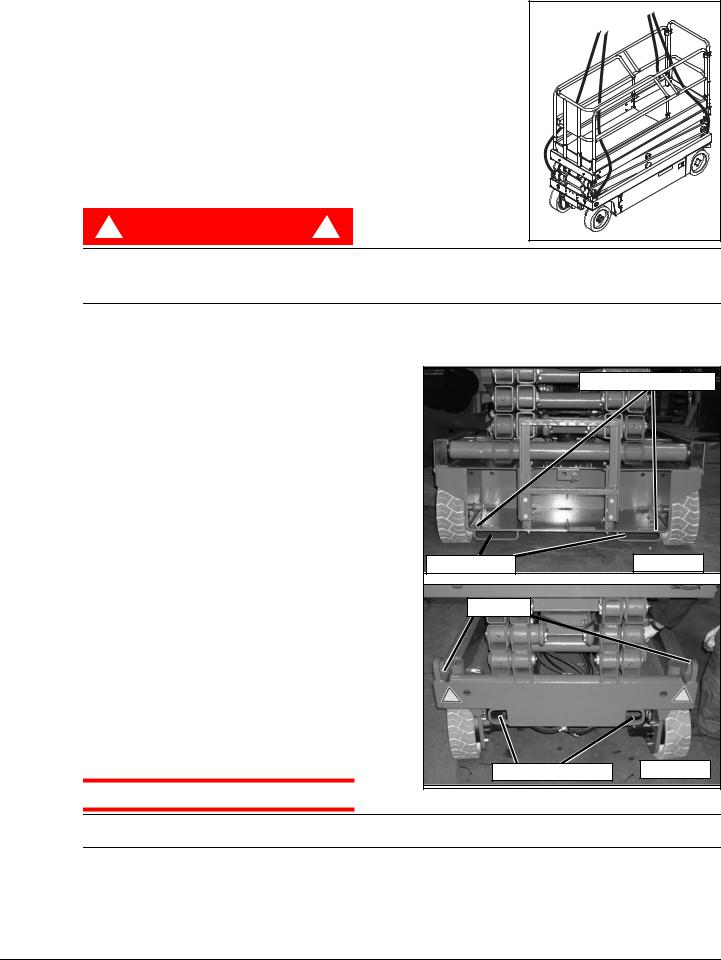
504165-002 |
Transporting the Work Platform |
Figure 6: Secure Crane Straps
LIFTING BY CRANE
1. Secure straps to chassis tie down/lifting lugs only.
2.Place the platform onto the transport vehicle in transport position.
3.Chock the wheels.
4.Secure the work platform to the transport vehicle with chains or
straps of adequate load capacity attached to the chassis tie down/lifting lugs.
BY FORKLIFT
!D A N G E R !
Forklifting is for transport only.
See specifications for weight of work platform and be certain that forklift is of adequate capacity to lift the work platform.
Forklift from the rear of the machine using the forklift pockets provided. If necessary, the machine may be forklifted from the side by lifting under the Chassis Modules.
DRI VI NG OR WINCHING ONTO
A TRUCK OR TRAILER
NOTE: Do not winch faster than 0,3 m/s (1 ft/s).
1.Move the machine onto the truck or trailer;
A.To Drive the machine onto the transport vehicle:
a.Move the work platform up the ramp and into transport position.
b.Set the wheels straight and turn off the machine.
c.Chock the wheels.
B.To Winch the machine onto the transport vehicle:
a.Move the work platform up to the ramp.
b.Attach the winch cable to the tie down/lifting lugs.
c.Release the parking brakes (refer to “Towing or Winching” on page 11).
d.Winch the platform into transport position
e.Chock the wheels.
2.Secure the work platform to the transport vehicle with chains or straps of adequate load capacity attached to the chassis tie down/lifting lugs.
C A U T I O N
|
Figure 7: Transporting the Work Platform |
|
|
Rear Tie Down/Lift Lugs |
|
Forklift Pockets |
|
REAR |
Lift Lugs |
|
|
Front Tie Down Lugs |
FRONT |
|
|
||
Over tightening of the chains or straps attached to the Tie Down/Lifting Lugs may result in damage to work platform.
Page 12 |
Operation Manual |

Maintenance |
504165-002 |
MAINTENANCE
! W A R N I N G !
Never perform service while the platform is elevated without first blocking the elevating assembly.
DO NOT stand in the elevating assembly area while deploying or storing the brace.
Figure 8: Scissor Brace
BLOCKING THE ELEVATING |
|
|
ASSEMBLY |
|
|
SCISSOR BRACE INSTALLATION |
|
|
1. |
Park the work platform on a firm, level surface. |
Pin Rests on Brace |
|
|
when in Blocking |
2. |
Pull Chassis EMERGENCY STOP Switch to the ON position. |
Position |
3.Pull Platform EMERGENCY STOP Switch to the ON position.
4.Turn and hold the Chassis Key Switch to CHASSIS.
5. |
Push the Chassis Lift/Lower Switch to LIFT to elevate the |
Scissor Brace in |
||
Rest Position |
|
|||
|
platform until the Scissor Brace can be rotated to the vertical |
Brace Rotates to |
||
|
position. |
|||
|
Blocking Position |
|
|
|
|
|
|||
6. |
X26 – From the rear of the machine, lift the Scissor Brace |
|
|
|
|
from its stowed position. Rotate upward and outward, then |
|
|
|
|
down until it is hanging vertically below its attachment point. |
|
|
|
7. |
X32 – From the left side of the machine, pull the locking pin |
|
|
|
|
securing the brace. Rotate the Scissor Brace counter clock- |
Brace Rests on Pin |
||
|
wise until it is in the vertical position. |
|||
|
when in Blocking |
|||
8. |
Lower the platform by pushing the Chassis Lift/Lower Switch |
Position |
||
|
|
|
||
|
to LOWER and gradually lower the platform until the Scissor |
|
|
|
|
Brace is supporting the platform. |
|
|
|
SCISSOR BRACE STOWAGE
1.Using the Chassis Controls, gradually elevate the platform until the Scissor Brace is clear.
2.X26 – Rotate the Scissor Brace outward and upward over its mounting point until it rests in the stowed position.
3.X32 – Rotate the Scissor Brace clockwise until the locking pin engages.
4.Lower the platform by pushing the Chassis Lift/Lower Switch to LOWER to completely lower the platform.
Operation Manual |
Page 13 |

504165-002 |
|
|
Maintenance |
|
BATTER Y MAINTENANCE |
||
|
|
|
|
|
! W A R N I N G |
! |
|
|
|
|
|
Hazard of explosive gas mixture. Keep sparks, flame, and smoking material away from batteries. Always wear safety glasses when working near batteries.
Battery fluid is highly corrosive. Thoroughly rinse away any spilled fluid with clean water.
Always replace batteries with UpRight batteries or manufacturer approved replacements weighing 26,3 kg (58 lbs.) each.
•Check the battery fluid level daily, especially if the work platform is being used in a warm, dry climate.
•If electrolyte level is lower than 10 mm (3/8 in.) above the plates add distilled water only. DO NOT use tap water with high mineral content, as it will shorten battery life.
•Keep the terminals and tops of the batteries clean.
•Refer to the Service Manual to extend battery life and for complete service instructions.
BATTERY CHARGING
Figure 9: Battery Charger
Charge the batteries at the end of each work
shift or sooner if the batteries have been dis- Charger Plug charged.
! W A R N I N G !
Charge the batteries in a well ventilated area.
Do not charge the batteries when the work platform is near a source of sparks or flames.
Permanent damage to the batteries will result if |
Charger |
|
|
the batteries are not immediately recharged |
|
|
|
|
|
||
after discharging. |
|
|
|
Never leave the battery charger operating for more than two days.
Never disconnect the cables from the batteries when the charger is operating.
Keep the charger dry.
1.Check the battery fluid level. If the battery fluid level is lower than 10 mm (3/8 in.) above the plates add distilled water only.
2.Connect an appropriate extension cord to charger outlet plug in Left Module Door. Plug the extension cord into a properly grounded outlet of proper voltage and frequency.
3.The charger turns on automatically after a short delay. The LED charge indicator will illuminate. After completion of the charge cycle the LED will blink, indicating that the charger is in a continuing maintenance mode. DO NOT leave the charger plugged in for more than 48 hours, as permanent damage to the batteries may occur.
NOTE: The battery charger circuit must be used with a GFI (Ground Fault Interrupt) outlet.
NOTE: DO NOT operate the machine while the charger is plugged in.
Page 14 |
Operation Manual |

Inspection and Maintenance Schedule |
504165-002 |
INSPECTION AND MAINTENANCE SCHEDULE |
|
The Complete Inspection consists of periodic visual and operational checks, along with periodic minor adjustments that assure proper performance. Daily inspection will prevent abnormal wear and prolong the life of all systems. The inspection and maintenance schedule should be performed at the specified intervals. Inspection and maintenance shall be performed by personnel who are trained and familiar with mechanical and electrical procedures.
! W A R N I N G !
Before performing preventative maintenance, familiarize yourself with the operation of the machine.
Always block the elevating assembly whenever it is necessary to perform maintenance while the platform is elevated.
The daily preventative maintenance checklist has been designed for machine service and maintenance. Please photocopy this page and use the checklist when inspecting the machine.
DAILY PREVENTATIVE MAINTENANCE CHECKLIST
MAINTENANCE TABLE KEY
Y = Yes/Acceptable
N = No/Not Acceptable
R = Repaired/Acceptable
COMPONENT |
INSPECTION OR SERVICES |
Y |
N |
R |
|
|
|
|
|
Battery |
Check electrolyte level. |
|
|
|
|
|
|
|
|
Check battery cable condition. |
|
|
|
|
|
|
|
|
|
|
|
|
|
|
Chassis |
Check hoses for pinch or rubbing points. |
|
|
|
|
|
|
|
|
Check welds for cracks. |
|
|
|
|
|
|
|
|
|
|
|
|
|
|
Control Cable |
Check the exterior of the cable for pinching, |
|
|
|
binding or wear. |
|
|
|
|
|
|
|
|
|
|
|
|
|
|
Controller |
Check switch operation. |
|
|
|
|
|
|
|
|
Drive Motors |
Check for operation and leaks. |
|
|
|
|
|
|
|
|
Elevating |
Inspect for structural cracks. |
|
|
|
Assembly |
|
|
|
|
|
|
|
|
|
|
|
|
|
|
Emergency |
Operate the emergency lowering valve and check |
|
|
|
Lowering System |
for serviceability. |
|
|
|
|
|
|
|
|
Entire Unit |
Check for and repair collision damage. |
|
|
|
|
|
|
|
|
PREVENTATIVE MAINTENANCE REPORT
Date:_______________________________________
Owner: _____________________________________
Model No: ___________________________________
Serial No: ___________________________________
Serviced By: _________________________________
COMPONENT |
INSPECTION OR SERVICES |
Y |
N |
R |
|
|
|
|
|
Hydraulic Fluid |
Check fluid level. |
|
|
|
|
|
|
|
|
Hydraulic Pump |
Check for hose fitting leaks. |
|
|
|
|
|
|
|
|
Hydraulic System |
Check for leaks. |
|
|
|
|
|
|
|
|
Labels |
Check for peeling, missing, or unreadable labels |
|
|
|
& replace. |
|
|
|
|
|
|
|
|
|
|
|
|
|
|
Platform Deck |
Check welds for cracks. |
|
|
|
and Rails |
|
|
|
|
|
|
|
|
|
|
|
|
|
|
Platform Deck |
Check condition of deck. |
|
|
|
and Rails |
|
|
|
|
|
|
|
|
|
|
|
|
|
|
Tyres and Wheels |
Check for damage. |
|
|
|
|
|
|
|
|
Operation Manual |
Page 15 |

504165-002 |
Daily Preventative Maintenance Checklist |
NOTES:
Page 16 |
Operation Manual |

Decals |
504165-002 |
DECALS
These labels shall be present and in good condition before operating the work platform. Be sure to read, understand and follow these labels when operating the work platform.
Operation Manual |
Page 17 |
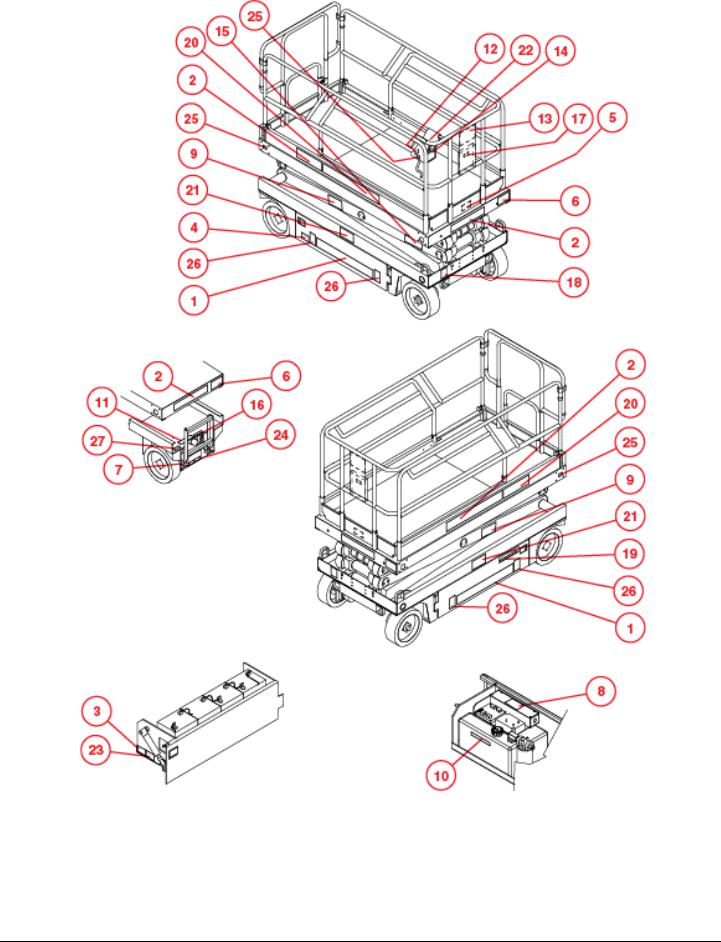
504165-002 |
Decals |
DECALS
Page 18 |
Operation Manual |

Specifications |
|
504165-002 |
|||
SPECIFICATIONS |
|
|
|
|
|
|
|
|
|
|
|
|
ITEM |
X26 |
|
X32 |
|
|
|
|
|
|
|
|
Platform Size w/ Extension |
1,17 m x 2,21 m |
|
1.17 m x 2.21 m |
|
|
[44,25 pulg. x 87 pulg.] |
|
[44 in. x 87 in.] |
|
|
|
|
|
|
||
|
|
|
|
|
|
|
Max. Platform Capacity |
|
|
|
|
|
Standard |
454 kg [1000 lb] |
|
340 kg [750 lbs.] |
|
|
on Extension |
113 kg [250 lb] |
|
113 kg [250 lbs.] |
|
|
|
|
|
|
|
|
Max. No. of occupants |
|
|
|
|
|
Standard (total) |
4 personas |
|
3 people |
|
|
|
2 personas en el exterior |
|
|
|
|
|
|
|
|
|
|
on Extension |
1 persona |
|
1 person |
|
|
|
|
|
|
|
|
Height |
|
|
|
|
|
Working Height |
9,93 m [32,58 pies] |
|
11.6 m [38.1 ft.] |
|
|
Max. Platform Height |
7,93 m [26 pies] |
|
9.75 m [32 ft.] |
|
|
Min. Platform Height |
1,09 m [43 pulg.] |
|
1.22 m [48 in.] |
|
|
|
|
|
|
|
|
Dimensions |
|
|
|
|
|
Weight |
2153 kg [4747 lb] |
|
2486 kg [5481 lbs.] |
|
|
Overall Width |
1,22 m [48 pulg.] |
|
1.22 m [48 in.] |
|
|
Overall Height |
2,19 m [83,5 pulg.] |
|
2.32 m [88.5 in.] |
|
|
Overall Height, Rails Lowered |
1,98 m [78 pulg.] |
|
1.88 m [74 in.] |
|
|
Overall Length, Extension In |
2,35 m [92,5 pulg.] |
|
2.35 m [92.5 in.] |
|
|
Overall Length, Extension Out |
3,26 m [128,5 pulg.] |
|
3.26 m [128.5 in.] |
|
|
|
|
|
|
|
|
Drivable Height |
7,93 m [26 pies] |
|
9.75 m [32 ft.] |
|
|
|
|
|
|
|
|
Drive Speed |
|
|
|
|
|
Platform Lowered |
0 to 3,2 km/h [0 to 2.0 mph] |
|
||
|
Platform Raised |
0 to 1 km/h [0 to 0.62 mph] |
|
||
|
|
|
|
||
|
Energy Source |
24 Volt Battery Pack (4-220 A Hour, 6 Volt Batteries, min. wt. 28.12 kg |
|
||
|
[62 lbs.] each) |
|
|||
|
|
|
|||
|
|
|
|
||
|
Motor |
24 Volt 4 Horse Power DC Electric Motor |
|
||
|
|
|
|
||
|
System Voltage |
24 Volt DC |
|
||
|
|
|
|
||
|
Battery Charger |
25 A, 110/220 V AC |
|
||
|
|
|
|
||
|
Battery Duty Cycle |
25% for 8 Hours |
|
||
|
|
|
|
|
|
|
Hydraulic Tank Capacity |
15 L [4 US Gallons] |
|
19 L [5 US Gallons] |
|
|
|
|
|
|
|
|
Maximum Hydraulic Pressure |
207 bar |
[3000 psi] |
|
|
|
|
|
|
|
|
|
Hydraulic Fluid |
|
|
|
|
|
Normal Temperature (>32° F [0° C]) |
|
ISO #46 |
|
|
|
Low Temperature (<32° F [0° C]) |
|
ISO #32 |
|
|
|
Extreme Temperature (<0° F [-17° C]) |
|
ISO #15 |
|
|
|
|
|
|
|
|
|
Lift System |
One Single Stage |
|
Two Single Stage |
|
|
Lift Cylinder |
|
Lift Cylinders |
|
|
|
|
|
|
||
|
|
|
|
|
|
|
Lift Speed |
Raise, 45 sec./Lower 40 sec. |
|
Raise, 65 sec./Lower 40 sec. |
|
|
|
|
|
|
|
|
Control System |
Proportional Control Handle with Interlock Switch, Rotary Drive/Lift Switch, |
|
||
|
and Red Mushroom EMERGENCY STOP Switch |
|
|||
|
|
|
|||
|
|
|
|
||
|
Drive System |
Dual Front Wheel Hydraulic Motors |
|
||
|
|
|
|
||
|
Tires |
381 mm [15 in.] Diameter Solid Rubber, non-marking |
|
||
|
|
|
|
||
|
Parking Brake |
Dual Spring Applied, Hydraulic Release |
|
||
|
|
|
|
||
|
Turning Radius |
203 mm [8 in.] Inside |
|
||
|
|
|
|
|
|
|
Maximum Gradeability |
12° [22%] |
|
12° [22%] |
|
|
|
|
|
|
|
|
Wheel Base |
1.9 m |
[74.75 in.] |
|
|
|
|
|
|
||
|
Guardrails |
1.02 m [40 in.] High |
|
||
|
|
|
|
|
|
|
Noise Level |
|
|
|
|
|
|
|
|
|
|
*Specifications are subject to change without notice. Hot weather or heavy use may affect performance. Refer to the Service Manual for complete parts and service information.
This machine meets or exceeds all applicable CE and GS machinery directive requirements.
Operation Manual |
Page 19 |

504165-002 |
Specifications |
Page 20 |
Operation Manual |
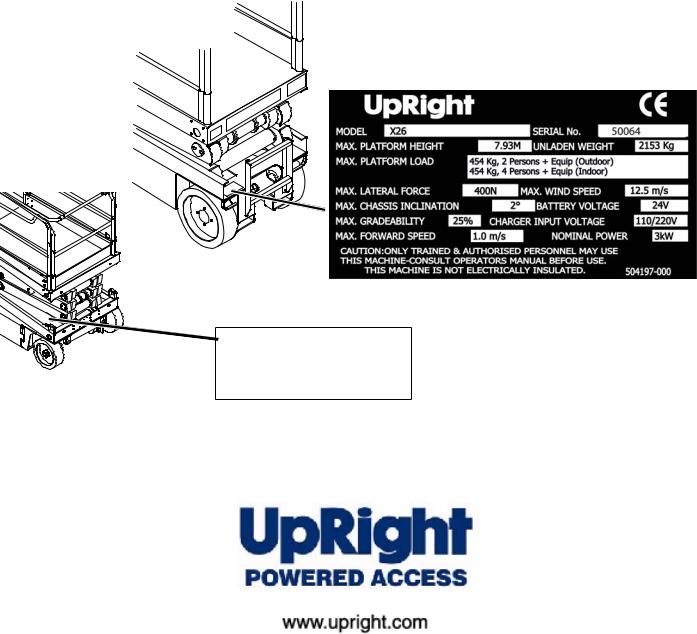
X 26-32
X26 Seriennummern 50906 – 53099
X32 Seriennummern 50322 – 53099
DEUTSCH
Stellen Sie sicher, dass Sie die MODELLund SERIENNUMMERN auf dem Gerätetypenschild angeben, wenn Sie sich mit UpRight bezüglich Wartungsoder Ersatzteilinformationen in Verbindung setzen. Sollte das Typenschild fehlen, finden Sie die SERIENNUMMER auch auf dem Fahrwerk über der vorderen Schwenkachse.
Stamped Serial Number
Estampille de numéro de série
Eingestanzte Seriennummer
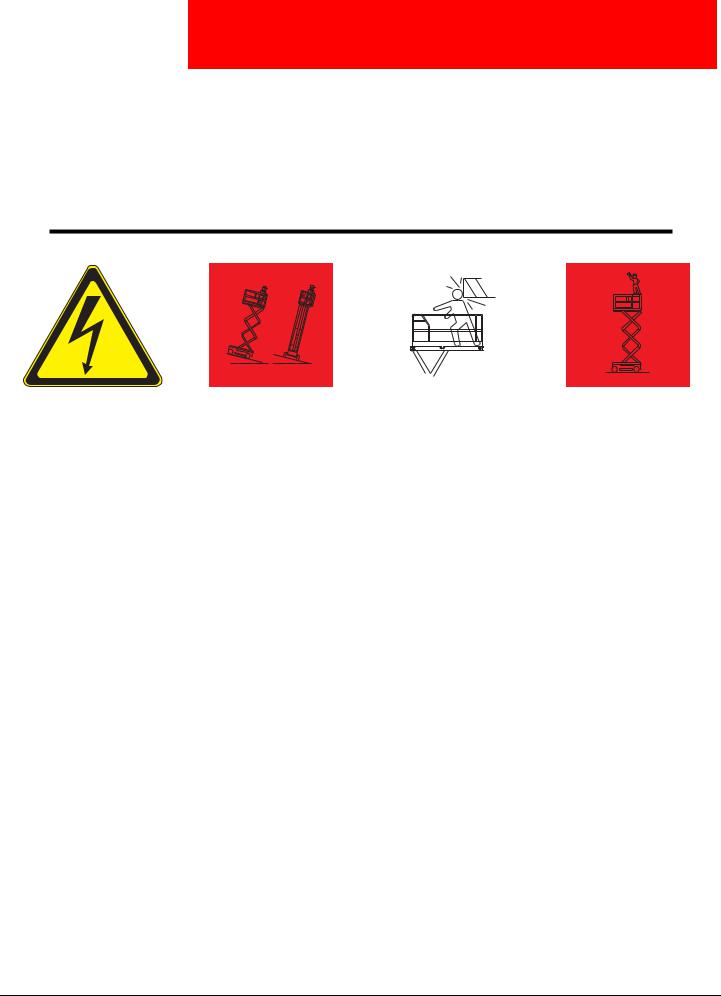
BETRIEBSANLEITUNG
WARNUNG
Alle Bediener müssen die Sicherheitsregeln und Betriebsanleitungen gründlich durchlesen, verstehen und befolgen, bevor sie an irgendeiner UpRight-Hocharbeitsbühne Wartungsarbeiten ausführen oder die Arbeitsbühne in Betrieb nehmen .
Sicherheitsregeln
Elektroschockgefahr |
Kippgefahr |
Kollisionsgefahr |
Sturzgefahr |
|
NIEMALS die Plattform ausfahren |
|
|
|
NIEMALS auf das obere |
|
DIESE MASCHINE IST NICHT |
|
Plattform NIEMALS in Position |
||||
oder die Maschine mit ausgefahrener |
bringen, ohne vorher sicherzustellen, |
oder mittlere Gestänge |
||||
ISOLIERT! |
||||||
Plattform fortbewegen, wenn sich die |
dass der Bereich über der Plattform |
des Plattformgeländers klettern |
||||
|
||||||
|
Maschine nicht auf einer festen, |
frei von Hindernissen und anderen |
und auch nicht darauf stehen |
|||
|
||||||
|
ebenen Fläche befindet. |
|
Gefahren ist. |
oder sitzen. |
||
EINSATZ DER HOCHARBEITSBÜHNE: Diese Hocharbeitsbühne dient dazu, Personen und Werkzeuge sowie die für die jeweilige Arbeit erforderlichen Materialien zu transportieren. Sie wurde speziell für Reparaturund Montagearbeiten sowie für Einsatzbereiche konzipiert, die sich oberhalb der Mitarbeiter befinden, sodass die Mitarbeiter nach oben gerichtet arbeiten müssen (z. B. Decken, Kräne, Dachst rukturen, Gebäude etc.). Jede andere Verwendung der Hocharbeitsbühne ist strikt verboten!
DIESE HOCHARBEITSBÜHNE IST NICHT ISOLIERT! Aus diesem Grund muss zwingend ein Sicherheitsabstand zu allen leitfähigen Teilen der elektrischen Ausrüstung eingehalten werden!
Die angegebene zulässige Höchstlast darf nicht überschritten werden!Nähere Informationen hierzu finden Sie im Abschnitt “Beschränkungen” auf Seite 4.
Es ist strikt verboten, die Hocharbeitsbühne als Hubwerkzeug oder Kran einzusetzen (d. h. um Lasten von unten nach oben oder von oben nach unten zu befördern).
Die für diese Maschine zulässige manuelle Kraft NIEMALS überschreiten.Nähere Informationen hierzu finden Sie im Abschnitt “Beschränkungen” auf Seite 4.
Lasten immer gleichmäßig auf der Plattform VERTEILEN.
Vor Inbetriebnahme der Maschine IMMER ZUERST die Aufstellfläche im Arbeitsbereich auf Gefahren wie Bodenlöcher, ausgelaufene Flüssigkeiten, Bodenerhebungen, Kanten oder Schutt untersuchen und diese umgehen bzw. beseitigen.
Maschine nur auf Oberflächen IN BETRIEB NEHMEN, die die zulässigen Radlasten aufnehmen können.
Maschine NIEMALS in Betrieb nehmen, wenn die tatsächliche Windgeschwindigkeit höher ist als die Windgeschwindigkeit, für die die Maschine ausgelegt ist. Nähere Informationen hierzu finden Sie im Abschnitt “Beaufort-Skala” auf Seite 4.
IM NOTFALL NOT-AUS-Schalter drücken, um alle strombetriebenen Funktionen zu deaktivieren.
WENN EIN ALARM ERTÖNT , während die Plattform ausgefahren wird, Plattform ANHALTEN und vorsichtig einfahren (absenken). Maschine auf feste, ebene Oberfläche fahren.
Auf das Schutzgeländer der Plattform zu klettern, auf Gebäuden, Stahloder vorgefertigten Betonstrukturen zu stehen oder von der Plattform aus darauf zu klettern etc. ist verboten!
Das Schwingtor oder andere Komponenten des Schutzgeländers zu demontieren ist verboten! Vergewissern Sie sich immer, dass das Schwingtor geschlossen und sicher verriegelt ist!
Es ist verboten, das Schwingtor geöffnet zu halten (z. B. mit Befestigungsgurten), wenn die Arbeitsplattform ausgefahren wird!
Die Höhe oder Reichweite der Plattform durch Anbringen von Leitern, Gerüsten oder ähnlichen Vorrichtungen zu vergrößern ist verboten!
IMMER ZUERST die Hubvorrichtung blockieren, bevor bei ausgefahrener Plattform Wartungsoder Instandhaltungsarbeiten an der Maschine durchgeführt werden.
Maschine vor jedem Gebrauch sorgfältig auf Risse an Schweißstellen, lose oder fehlende Beschläge, Leckagen in der Hydraulikvorr ichtung, gelöste Kabelverbindungen und beschädigte Kabel oder Schläuche UNTERSUCHEN.
Vor Gebrauch SICHERSTELLEN, dass alle Bezeichnungsschilder ordnungsgemäß angebracht und vollständig lesbar sind.
NIEMALS eine Maschine benutzen, die beschädigt ist, nicht ordnungsgemäß funktioniert oder deren Bezeichnungsschilder Beschädigungen aufweisen oder sogar ganz fehlen.
Sicherheitseinrichtungen zu umgehen ist verboten und stellt eine Gefahr für alle Personen dar, die sich auf der Hocharbeitsbühne und in deren Arbeitsbereich befinden.
Batterien NIEMALS in der Nähe von Funkenquellen oder offenen Flammen aufladen. Beim Aufladen von Batterien wird explosives Wasserstoffgas freigesetzt.
Änderungen an der Hocharbeitsbühne sind verboten bzw. nur mit ausdrücklicher Genehmigung von UpRight zulässig.
NACH GEBRAUCH ist die Hocharbeitsbühne gegen unbefugten Gebrauch durch Dritte zu sichern. Hierzu müssen beide Schlüsselschalter auf “Aus” gestellt und die Schlüssel abgezogen werden.
Seite 1

504165-002
INHALT
Einführung. . . . . . . . . . . . . . . . . . . . . . . . . . . . . . . . . . . . . . . . . . . . . . . . . . . . . . . . . . . . . . . . . . . . . . . . . . .3 Allgemeine Beschreibung . . . . . . . . . . . . . . . . . . . . . . . . . . . . . . . . . . . . . . . . . . . . . . . . . . . . . . . . . . . . . .3
Beschränkungen. . . . . . . . . . . . . . . . . . . . . . . . . . . . . . . . . . . . . . . . . . . . . . . . . . . . . . . . . . . . . . . . . . . . . .4
Tragfähigkeit der Plattform . . . . . . . . . . . . . . . . . . . . . . . . . . . . . . . . . . . . . . . . . . . . . . . . . . . . . . . . . . . . . . . . . . . . 4 Manuelle Kraft . . . . . . . . . . . . . . . . . . . . . . . . . . . . . . . . . . . . . . . . . . . . . . . . . . . . . . . . . . . . . . . . . . . . . . . . . . . . . . 4 Beaufort-Skala. . . . . . . . . . . . . . . . . . . . . . . . . . . . . . . . . . . . . . . . . . . . . . . . . . . . . . . . . . . . . . . . . . . . . . . . . . . . . . 4 Überlastalarm . . . . . . . . . . . . . . . . . . . . . . . . . . . . . . . . . . . . . . . . . . . . . . . . . . . . . . . . . . . . . . . . . . . . . . . . . . . . . . 4
Bedienelemente und Anzeigen . . . . . . . . . . . . . . . . . . . . . . . . . . . . . . . . . . . . . . . . . . . . . . . . . . . . . . . . . .5 Sicherheitsprüfung vor Inbetriebnahme . . . . . . . . . . . . . . . . . . . . . . . . . . . . . . . . . . . . . . . . . . . . . . . . . .6 Überprüfung der Systemfunktionen . . . . . . . . . . . . . . . . . . . . . . . . . . . . . . . . . . . . . . . . . . . . . . . . . . . . . .7
Bedienung . . . . . . . . . . . . . . . . . . . . . . . . . . . . . . . . . . . . . . . . . . . . . . . . . . . . . . . . . . . . . . . . . . . . . . . . . . .8
Plattformverlängerung . . . . . . . . . . . . . . . . . . . . . . . . . . . . . . . . . . . . . . . . . . . . . . . . . . . . . . . . . . . . . . . . . . . . . . . . 8 Fahren mit eingefahrener Plattform. . . . . . . . . . . . . . . . . . . . . . . . . . . . . . . . . . . . . . . . . . . . . . . . . . . . . . . . . . . . . . 8 Lenken. . . . . . . . . . . . . . . . . . . . . . . . . . . . . . . . . . . . . . . . . . . . . . . . . . . . . . . . . . . . . . . . . . . . . . . . . . . . . . . . . . . . 8 Ausfahren der Plattform . . . . . . . . . . . . . . . . . . . . . . . . . . . . . . . . . . . . . . . . . . . . . . . . . . . . . . . . . . . . . . . . . . . . . . 8 Fahren mit ausgefahrener Plattform . . . . . . . . . . . . . . . . . . . . . . . . . . . . . . . . . . . . . . . . . . . . . . . . . . . . . . . . . . . . . 9 Einfahren der Plattform . . . . . . . . . . . . . . . . . . . . . . . . . . . . . . . . . . . . . . . . . . . . . . . . . . . . . . . . . . . . . . . . . . . . . . . 9 Notfallabsenkung. . . . . . . . . . . . . . . . . . . . . . . . . . . . . . . . . . . . . . . . . . . . . . . . . . . . . . . . . . . . . . . . . . . . . . . . . . . . 9
X26. . . . . . . . . . . . . . . . . . . . . . . . . . . . . . . . . . . . . . . . . . . . . . . . . . . . . . . . . . . . . . . . . . . . . . . . . . . . . . . . . . . 9 X32. . . . . . . . . . . . . . . . . . . . . . . . . . . . . . . . . . . . . . . . . . . . . . . . . . . . . . . . . . . . . . . . . . . . . . . . . . . . . . . . . . . 9 Absenken des Schutzgeländers, X26 . . . . . . . . . . . . . . . . . . . . . . . . . . . . . . . . . . . . . . . . . . . . . . . . . . . . . . . . . . . 10 Absenken . . . . . . . . . . . . . . . . . . . . . . . . . . . . . . . . . . . . . . . . . . . . . . . . . . . . . . . . . . . . . . . . . . . . . . . . . . . . . 10 Anheben. . . . . . . . . . . . . . . . . . . . . . . . . . . . . . . . . . . . . . . . . . . . . . . . . . . . . . . . . . . . . . . . . . . . . . . . . . . . . . 10 Einklappen des Schutzgeländers, X32 . . . . . . . . . . . . . . . . . . . . . . . . . . . . . . . . . . . . . . . . . . . . . . . . . . . . . . . . . . 11 Einklappen . . . . . . . . . . . . . . . . . . . . . . . . . . . . . . . . . . . . . . . . . . . . . . . . . . . . . . . . . . . . . . . . . . . . . . . . . . . . 11 Ausklappen . . . . . . . . . . . . . . . . . . . . . . . . . . . . . . . . . . . . . . . . . . . . . . . . . . . . . . . . . . . . . . . . . . . . . . . . . . . 11
Schleppen oder Anheben . . . . . . . . . . . . . . . . . . . . . . . . . . . . . . . . . . . . . . . . . . . . . . . . . . . . . . . . . . . . .12
Lösen der Parkbremse . . . . . . . . . . . . . . . . . . . . . . . . . . . . . . . . . . . . . . . . . . . . . . . . . . . . . . . . . . . . . . . . . . . . . . 12 Nach dem täglichen Gebrauch . . . . . . . . . . . . . . . . . . . . . . . . . . . . . . . . . . . . . . . . . . . . . . . . . . . . . . . . . . . . . . . . 12 Betriebsstundenzähler. . . . . . . . . . . . . . . . . . . . . . . . . . . . . . . . . . . . . . . . . . . . . . . . . . . . . . . . . . . . . . . . . . . . . . . 12
Transport der Arbeitsbühne . . . . . . . . . . . . . . . . . . . . . . . . . . . . . . . . . . . . . . . . . . . . . . . . . . . . . . . . . . . |
13 |
Vorbereitung . . . . . . . . . . . . . . . . . . . . . . . . . . . . . . . . . . . . . . . . . . . . . . . . . . . . . . . . . . . . . . . . . . . . . . . . . . . . . . 13 Anheben per Kran . . . . . . . . . . . . . . . . . . . . . . . . . . . . . . . . . . . . . . . . . . . . . . . . . . . . . . . . . . . . . . . . . . . . . . . . . . 13 Per Gabelstapler . . . . . . . . . . . . . . . . . . . . . . . . . . . . . . . . . . . . . . . . . . . . . . . . . . . . . . . . . . . . . . . . . . . . . . . . . . . 13 Fahren oder Heben auf einen LKW oder Anhänger . . . . . . . . . . . . . . . . . . . . . . . . . . . . . . . . . . . . . . . . . . . . . . . . 13
Instandhaltung . . . . . . . . . . . . . . . . . . . . . . . . . . . . . . . . . . . . . . . . . . . . . . . . . . . . . . . . . . . . . . . . . . . . . .14
Blockieren der Hubvorrichtung . . . . . . . . . . . . . . . . . . . . . . . . . . . . . . . . . . . . . . . . . . . . . . . . . . . . . . . . . . . . . . . . 14 Installation der Scherenverstrebung . . . . . . . . . . . . . . . . . . . . . . . . . . . . . . . . . . . . . . . . . . . . . . . . . . . . . . . . 14 Verstauen der Scherenverstrebung . . . . . . . . . . . . . . . . . . . . . . . . . . . . . . . . . . . . . . . . . . . . . . . . . . . . . . . . . 14 Instandhaltung der Batterie . . . . . . . . . . . . . . . . . . . . . . . . . . . . . . . . . . . . . . . . . . . . . . . . . . . . . . . . . . . . . . . . . . . 15 Aufladen der Batterien . . . . . . . . . . . . . . . . . . . . . . . . . . . . . . . . . . . . . . . . . . . . . . . . . . . . . . . . . . . . . . . . . . . 15
Inspektionsund Instandhaltungsplan . . . . . . . . . . . . . . . . . . . . . . . . . . . . . . . . . . . . . . . . . . . . . . . . . . .16 Checkliste der täglichen präventiven Instandhaltungsmaßnahmen . . . . . . . . . . . . . . . . . . . . . . . . . . .16 Bezeichnungsschilder . . . . . . . . . . . . . . . . . . . . . . . . . . . . . . . . . . . . . . . . . . . . . . . . . . . . . . . . . . . . . . . .18 Technische Daten . . . . . . . . . . . . . . . . . . . . . . . . . . . . . . . . . . . . . . . . . . . . . . . . . . . . . . . . . . . . . . . . . . . .20
Seite 2 |
Betriebsanleitung |
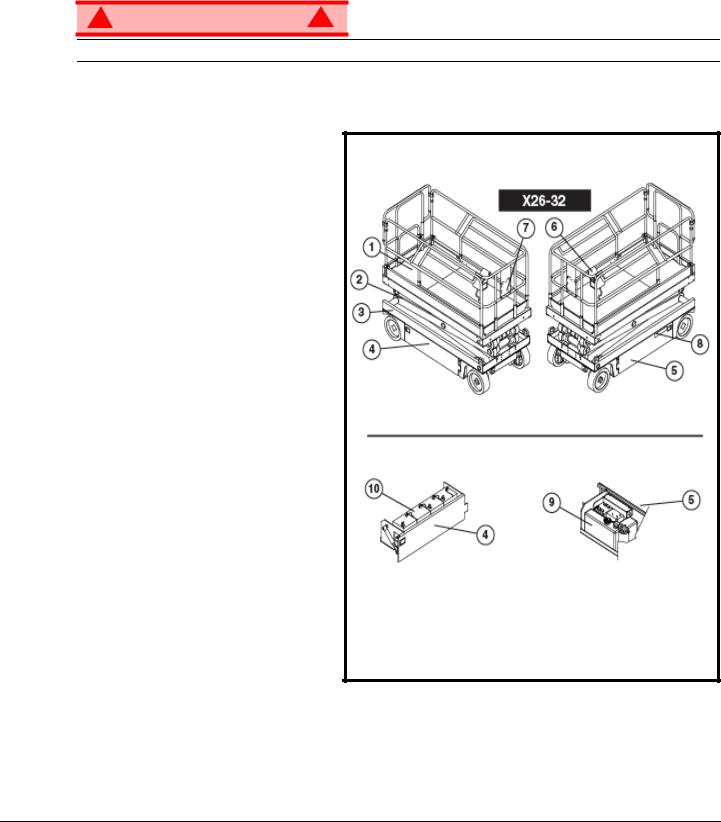
Einführung |
504165-002 |
EINFÜHRUNG
Dieses Handbuch beschreibt Einsatz und Bedienung der selbstfahrenden Arbeitsbühnen der X 26-32.
Das Handbuch muss immer bei der Maschine aufbewahrt werden.
ALLGEMEINE BESCHREIBUNG
! W A R N U N G !
Hocharbeitsbühne NICHT ohne korrekt montiertes und angebrachtes Schutzgeländer verwenden.
Abbildung 1: X 26-32
1.Plattform
2.Hubvorrichtung
3.Fahrwerk
4.Leistungsmodul
5.Steuermodul
6.Plattform-Bedienelemente
7.Handbuchfach
8.Fahrwerk-Bedienelemente
9.Behälter für Hydraulikflüssigkeit
10.Batterien
Betriebsanleitung |
Seite 3 |
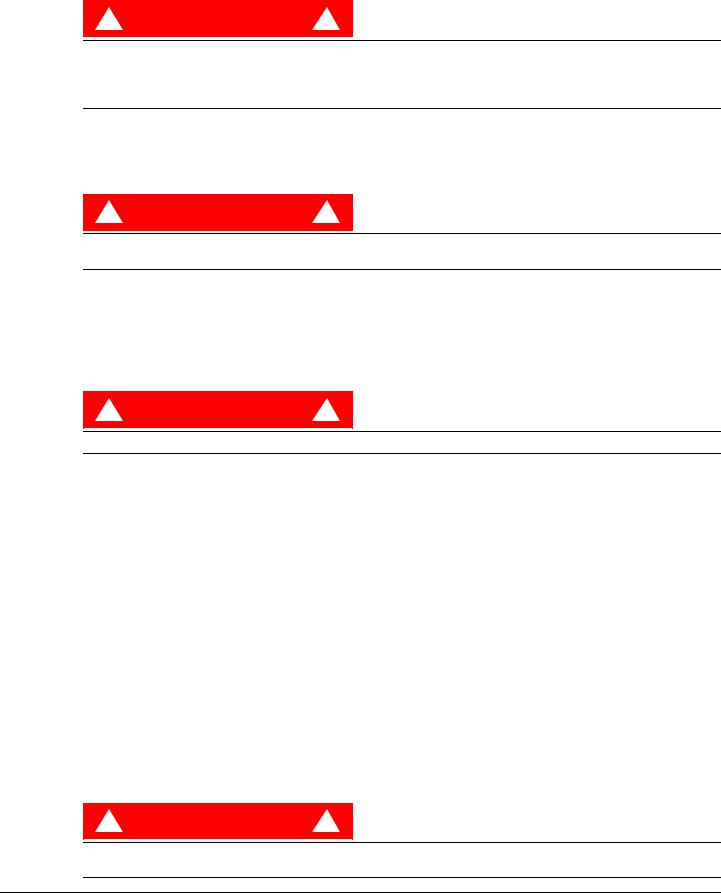
504165-002 |
Beschränkungen |
BESCHRÄNKUNGEN
Bei ausgefahrener Plattform kann die Maschine nur im Schleichgang gefahren werden.
Die Arbeitsplattform kann nur auf festen, ebenen Oberflächen ausgefahren werden.
! G E F A H R !
Die Hubfunktion darf NUR verwendet werden, wenn die Hocharbeitsbühne nivelliert ist und auf einer festen Oberfläche steht.
Die Hocharbeitsbühne ist NICHT dafür ausgelegt, auf unebenem, grobem oder weichem Gelände gefahren zu werden.
TRAGFÄHIGKEIT DER PLATTFORM
Die maximale Tragfähigkeit der MASCHINE, einschließlich Personen, hängt vom Modell und verschiedenen Optionen ab; Sie finden eine entsprechende Liste im Abschnitt “” auf Seite 19.
! G E F A H R !
Maximale Tragfähigkeit der Plattform oder maxima l zulässige Personenzahl für diese Maschine NICHT überschreiten.
MANUELLE KRAFT
Unter manueller Kraft versteht man die Kraft, die die Personen auf der Plattform auf Objekte wie Wände oder andere Strukturen außerhalb der Arbeitsplattform ausüben.
Die maximal zulässige manuelle Kraft ist auf 200 N (45 lbs.) pro Person beschränkt, d. h. maximal 400 N (90 lbs.), wenn sich zwei oder mehr Personen auf der Plattform befinden.
! G E F A H R !
Die für diese Maschine maximal zulässig e manuelle Kraft NICHT überschreiten.
BEAUFORT -SKALA
Niemals die Maschine in Betrieb nehmen, wenn die Windgeschwindigkeit mehr als 25 km/h (15 mph) [Beaufort-Skala 4] beträgt.
BEAUFORT-WERT |
|
WINDGESCHWINDIGKEIT |
|
BODEN-/UMGEBUNGSBEDINGUNGEN |
||
m/s |
km/h |
ft/s |
mph |
|||
|
|
|||||
3 |
3,4~5,4 |
12,25~19,4 |
11.5~17.75 |
7.5~12.0 |
Papier und dünne Zweige bewegen sich, Fahnen wehen. |
|
4 |
5,4~8,0 |
19,4~28,8 |
17.75~26.25 |
12.0~18 |
Staub und Papier wird aufgewirbelt und kleine Zweige schaukeln. |
|
5 |
8,0~10,8 |
28,8~38,9 |
26.25~35.5 |
18~24.25 |
Sträucher mit Blättern beginnen zu schaukeln. In Teichen, Sümpfen oder anderen Gewässern |
|
erscheinen Wellenkämme. |
||||||
|
|
|
|
|
||
6 |
10,8~13,9 |
38,9~50,0 |
35.5~45.5 |
24.5~31 |
Zweige und Äste von Bäumen bewegen sich. Stromleitungen pfeifen. Regenschirme können nur mit |
|
Mühe geöffnet werden. |
||||||
|
|
|
|
|
||
7 |
13,9~17,2 |
50,0~61,9 |
45.5~56.5 |
31.~38.5 |
Ganze Bäume schwanken. Es ist schwierig, gegen den Wind zu gehen. |
|
ÜBERLASTALARM
Wenn eine Last angehoben wird, die 90 % der Nennlast ausmacht, erscheint im digitalen Display des Bedienpultes an der Plattform der Fehlercode “03”. Befindet sich im Fahrkorb eine Last, die höher als die Nennlast ist, werden alle Maschinenfunktionen blockiert und eine akustische Warnung ertönt. Damit der normale Betrieb wieder aufgenommen werden kann, muss die Last im Fahrkorb verringert werden, sodass sie gleich oder niedriger als die Nennlast ist, und die Stromzufuhr zur Maschine muss ausund wieder eingeschaltet werden. Das Ausund wieder Einschalten der Stromversorgung kann durch Drücken und anschließendes Lösen des Not-Aus-Tasters erfolgen.
! G E F A H R !
Niemals die Maschine in Betrieb nehmen, wenn sich auf der Arbeitsplattform eine Last befindet, die die angegebene Tragfähigkeit überschreitet.
Seite 4 |
Betriebsanleitung |
